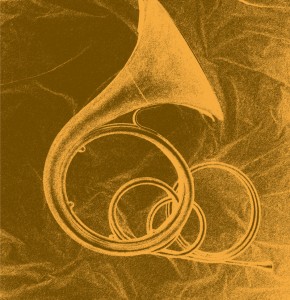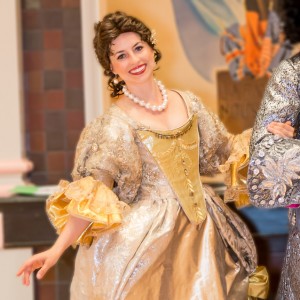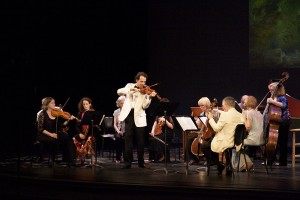Ever the approachable educator, Aston Magna Artistic Director takes the mystery out of those pesky musical history labels.
 The familiar, neat labels of music history — Renaissance, Baroque, Classical, Romantic, etc. – were not created during the periods to which they refer! These are retrospective tags given by historians and musicologists, based on broad-brush generalizations. They may be useful and help orient us in our listening or CD purchases, but because the repertoire of each of these periods is so rich and varied, it is difficult to say anything truly definitive about any one era.
The familiar, neat labels of music history — Renaissance, Baroque, Classical, Romantic, etc. – were not created during the periods to which they refer! These are retrospective tags given by historians and musicologists, based on broad-brush generalizations. They may be useful and help orient us in our listening or CD purchases, but because the repertoire of each of these periods is so rich and varied, it is difficult to say anything truly definitive about any one era.
For instance, the late Renaissance ushered in sophisticated composition of secular music (madrigals, opera), but it also saw much sacred music composed and published — a sort of reformation and counter-reformation. Composers like Monteverdi composed both polyphonic madrigals that employed older, contrapuntal techniques one found in church music, and the newer operatic monody that sought to wed drama and music.
This tension also occurred in the late Baroque: the “galante” style which preceded in what we call the “Classical era” consciously avoided the learned, complex counterpoint of composers like Bach, preferring pleasant melodies and uncomplicated harmony. The “Romantic” era (essentially the 19th century) favored long-lined melody, lavishly orchestrated, with a minimum of counterpoint (Schubert, Lizst, Wagner, Schumann), and yet Beethoven, Mendelssohn and Brahms excelled in fugues and organic, polyphonic composition, though with a “romantic” intensity, sweep and power.
 What can be definitively said was that starting in the 17th century, the relatively new invention of music publishing spread all kinds of music far and wide. There was a new emphasis on the sponsoring and commissioning of secular music – an outgrowth of the early Enlightenment impulses and the gradual rise of the middle class. More and more people took up amateur singing or instrumental playing, and instrument makers were all too happy to provide a wide array of new wind, string and keyboard instruments. The violin, harpsichord and eventually the piano flourished between 1600 and 1800. Flutes, oboes, clarinets and horns of various kinds evolved dramatically. Composers challenged singers and instrumentalists with more and more ornate music, giving rise to the retrospective label “Baroque,” a term which emerged in the years after its “official” and artificial end-date (1750, the year of Bach’s death), and was sometimes used derogatorily, indicating mannered and extravagant detail.
What can be definitively said was that starting in the 17th century, the relatively new invention of music publishing spread all kinds of music far and wide. There was a new emphasis on the sponsoring and commissioning of secular music – an outgrowth of the early Enlightenment impulses and the gradual rise of the middle class. More and more people took up amateur singing or instrumental playing, and instrument makers were all too happy to provide a wide array of new wind, string and keyboard instruments. The violin, harpsichord and eventually the piano flourished between 1600 and 1800. Flutes, oboes, clarinets and horns of various kinds evolved dramatically. Composers challenged singers and instrumentalists with more and more ornate music, giving rise to the retrospective label “Baroque,” a term which emerged in the years after its “official” and artificial end-date (1750, the year of Bach’s death), and was sometimes used derogatorily, indicating mannered and extravagant detail.
Aston Magna strives to recreate the sound and atmosphere of “early music.” Our primary repertoire is that of the 17th– through early 19th century, though we have pushed the envelope in both directions. For instance, we have done some  daring, chromatic vocal music of the 14th century, and we have also commissioned new works for baroque instruments. Vivaldi, Bach, Mozart, Beethoven and even Brahms sound quite different when heard on the instruments with which the composers were familiar with, and this is especially true when it is heard in venues much like the ones they wrote for – usually much smaller concert halls. The result is more intimate (the box office is smaller, alas!) and often the acoustical balances among the instruments are better than with “modern” instruments. A Mozart sonata for violin and keyboard, heard with fortepiano and gut strings on the violin, is a revelatory experience for player and listener alike.
daring, chromatic vocal music of the 14th century, and we have also commissioned new works for baroque instruments. Vivaldi, Bach, Mozart, Beethoven and even Brahms sound quite different when heard on the instruments with which the composers were familiar with, and this is especially true when it is heard in venues much like the ones they wrote for – usually much smaller concert halls. The result is more intimate (the box office is smaller, alas!) and often the acoustical balances among the instruments are better than with “modern” instruments. A Mozart sonata for violin and keyboard, heard with fortepiano and gut strings on the violin, is a revelatory experience for player and listener alike.
Good music of all ages features both polyphonic and monophonic episodes. Monteverdi composed church music in many voices, and also composed opera arias for one voice. Bach, well known for his contrapuntal genius, could also write a ravishing melody for one voice (think of the theme of the Goldberg Variations, or the “Air on the G String” – a standard today at weddings). Vivaldi, Handel, Mozart and Beethoven all composed grand fugues for dramatic effect, but they are better known as tunesmiths, and created so many imperishable, instantly recognized melodies.
 Baroque music (roughly 1600-1750) features a bass line (“basso continuo”) that forms a kind of harmonic bedrock for all kinds of musical forms, a lot of which are dance-related. One of the most common larger forms that Baroque composers employed was the partita – a collection of dance movements each of which represents a particular national style. Thus playing or listening to a partita is a sort of musical travelogue. The word “sonata” came into its own in the Baroque period. Originally it simply meant a piece played (suonata) by one or more instruments, as opposed to a “cantata,” a sung composition (with the accompaniment of one or more instruments). Another label that was born in this period was the sinfonia, an instrumental work for multiple instruments.
Baroque music (roughly 1600-1750) features a bass line (“basso continuo”) that forms a kind of harmonic bedrock for all kinds of musical forms, a lot of which are dance-related. One of the most common larger forms that Baroque composers employed was the partita – a collection of dance movements each of which represents a particular national style. Thus playing or listening to a partita is a sort of musical travelogue. The word “sonata” came into its own in the Baroque period. Originally it simply meant a piece played (suonata) by one or more instruments, as opposed to a “cantata,” a sung composition (with the accompaniment of one or more instruments). Another label that was born in this period was the sinfonia, an instrumental work for multiple instruments.
These generic terms experienced a transformation into set, multi-movement forms by the time of Mozart, Haydn and Beethoven. Renaissance madrigals are among the most romantic pieces I know, in the sense of conveying the vicissitudes of human love. Bach’s church music, with models from Medieval and Renaissance polyphony as well as 17th century opera, transcends the parochial religion of his time and is international in its appeal today. One can listen to his cantatas and be profoundly moved without necessarily absorbing the liturgical text, and yet contemplating his obvious devotion to his Lutheran creed makes one thoughtful and curious about the psychology of faith.
Bach was, in a sense a 16th century man living in the 18th century. His wide learning and his skills as a musician (organist, violinist, harpsichordist, composer, conductor, arranger, teacher, entrepreneur) are legendary, and it’s hard to imagine anyone more gifted and communicative. Perhaps only Mozart could rival him. Romantic music is more overtly emotional, perhaps, than music that came before. But that doesn’t mean that Handel, Bach, Mozart Haydn can’t bring one to tears. And it’s hard to imagine anything more torrid than Monteverdi’s love scenes between Nero and Poppea.
 I hope I have conveyed some of the vagaries of the classical music’s useful but simplistic labels. I encourage the serious listener to hear, without labels, the magic that can be conjured up by a good composer and sympathetic performers.
I hope I have conveyed some of the vagaries of the classical music’s useful but simplistic labels. I encourage the serious listener to hear, without labels, the magic that can be conjured up by a good composer and sympathetic performers.
~Daniel Stepner, Artistic Director
